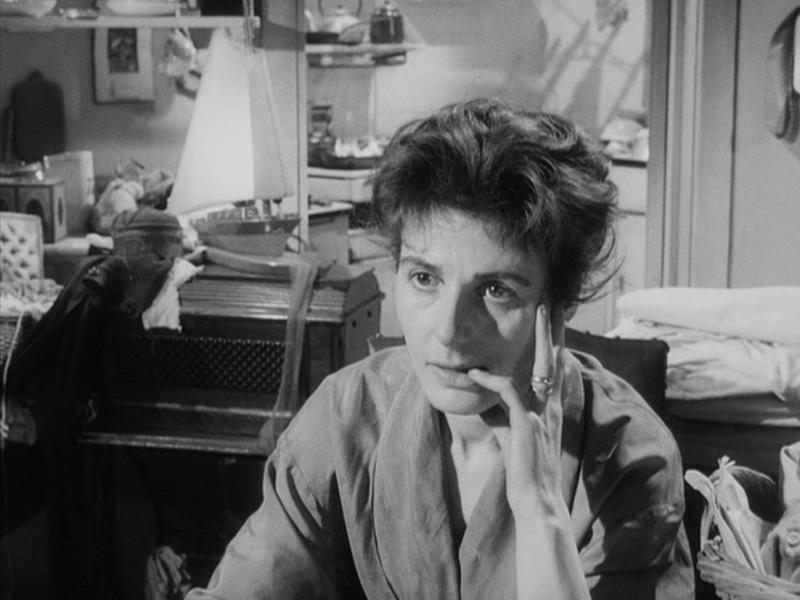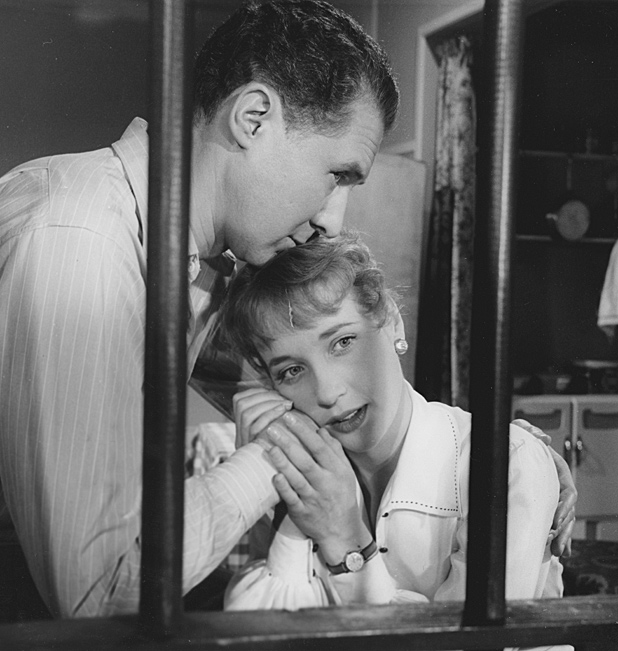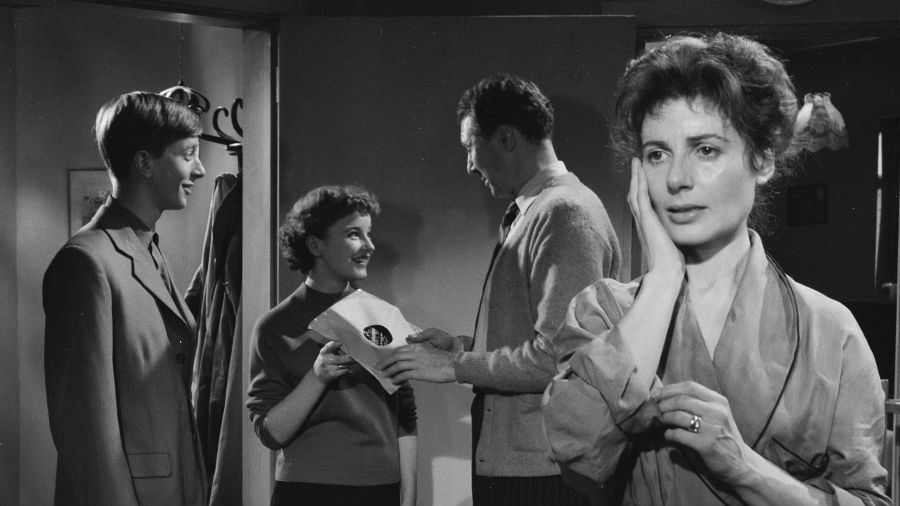Woman in a Dressing Gown | reviews, news & interviews
Woman in a Dressing Gown
Woman in a Dressing Gown
Yvonne Mitchell's revelatory acting illuminates the film that launched kitchen-sink drama

The British new wave came ashore with its angry young men – foremost among them those played by Laurence Harvey in Room at the Top (1959), Albert Finney in Saturday Night and Sunday Morning (1960), Tom Courtenay in The Loneliness of the Long-Distance Runner (1962), and Richard Harris in This Sporting Life (1963), all but Courtenay’s rebellious Nottingham borstal boy bloody-minded Northerners.
With the exception of Rita Tushingham’s character, pregnant and single in A Taste of Honey (1961), and Leslie Caron, pregnant, single, and French, in The L-Shaped Room (1962), the movement’s most memorable women – Rachel Roberts and Shirley Anne Field in Saturday Night, June Ritchie (knocked up by boyfriend Alan Bates) in A Kind of Loving (1962), and Roberts in This Sporting Life – played second fiddle to the men.
Of angry middle-aged housewives, there was but one: Amy Preston (Yvonne Mitchell) in the neo-realist Woman in a Dressing Gown (1957), which is habitually neglected in the kitchen-sink roll call. That will change with the re-release today and DVD release on 13 August of J. Lee Thompson’s suspenseful proto-feminist film, for which Mitchell won the Silver Bear for Best Actress at Berlin. It was actually the first kitchen-sink drama, and the one that defined the term.
 The suspense derives from the movie’s problem – will Jim (Anthony Quayle), Amy’s husband of 20 years, with whom she has a factory-worker son (Andrew Ray), stay with her or leave her for his young mistress, Georgie (Sylvia Syms, right with Quayle)?
The suspense derives from the movie’s problem – will Jim (Anthony Quayle), Amy’s husband of 20 years, with whom she has a factory-worker son (Andrew Ray), stay with her or leave her for his young mistress, Georgie (Sylvia Syms, right with Quayle)?
Like The L-Shaped Room, Woman in a Dressing Gown takes place in a dingy London shaped by austerity rather than Macmillan-era affluence. However, the understated sociological agenda of Ted Willis’s screenplay is concerned less with economics than the desensitising narrowness of Amy’s life. A hapless slattern who has given up on herself as a feminine, sexual being, Amy seldom changes out of her threadbare dressing gown, never cleans or tidies the family’s cramped London council flat, and invariably burns the meals she cooks.
Matching the movie’s mise-en-scène to its critique of the retrograde notion that a woman’s place is in the home, Thompson’s cinematographer Gilbert Taylor constantly frames her like a caged beast between table legs or behind window panes. Amy noticeably comes alive outside the mean confines of the flat – raucously so when she goes to the pub with Jim on a Sunday night after one of his secret liaisons with Georgie, later on an expedition to get her hair done in a heartrending attempt to make herself freshly attractive to him.
 Though Thompson is best known for masculine genre films like The Guns of Navarone (1961) and Cape Fear (1962), he had previously touched on a woman’s entrapment in Yield to the Night (1956), in which Diana Dors played an incarcerated murderess, partially inspired by Ruth Ellis, on the eve of her hanging.
Though Thompson is best known for masculine genre films like The Guns of Navarone (1961) and Cape Fear (1962), he had previously touched on a woman’s entrapment in Yield to the Night (1956), in which Diana Dors played an incarcerated murderess, partially inspired by Ruth Ellis, on the eve of her hanging.
Not realising that her future is as black as her toast, Amy remains stridently cheerful and takes pleasure in radio music, but from the beginning of the film until the emotional summit she requests with Jim and Georgie, she hovers on the brink of hysteria: it’s difficult to think of another performance by a British actress in which nervous intensity is so unshowily contained. Amy's malaise is a result of the psychological damage she has sustained, which is shared by Jim (scarcely the philandering type) and has cost him drive and ambition.
Willis quietly introduces, almost in passing, the source of the couple’s pain during the three-way parley that resolves how the film will end. The marriage's fate hinges on the familiar contest between the value of love as devotion that endures suffering and the daily grind and the value of love as gratified desire.
Battle for her man elicits Amy's long-dormant fierceness that makes her look and sound beautiful
This third-act meeting reveals that Jim is the weakest of the three and that Georgie, who has coldly rationalised why Jim should leave Amy, is not quite the “fish” Amy dubs her. She apologises to Amy for the trauma the affair with Jim has caused her, but it’s Amy’s reasoning that has moral weight behind it. “Didn’t you have the strength to leave him alone?” she demands of her rival.
Roused to action after years of denial and self-deprecation, Amy is transformed. The battle for her man elicits her long-dormant fierceness that makes her look and sound beautiful. The scene where she orders Jim to get out and to keep his money because she intends to get a job is one that would embolden any woman who has been passed over for a younger model.
Mitchell (1915-79) is revelatory in Woman in a Dressing Gown, which seems fresher than most kitchen-sink films. Her great perfomance makes one hungry to know more about her. In stage plays – a four-decade endeavour – and films like The Divided Heart (1954) and Sapphire (1959), she was an actor who often chose socially challenging subjects. On TV in the mid-Fifties, she was acclaimed for her Cathy Earnshaw and her Julia (opposite Peter Cushing) in Nineteen Eighty-Four. She was also an award-winning playwright, a novelist, and an acclaimed biographer of Colette. Only survivalism links the celebrated French author with the dowdy Amy Preston – that and inextinguishable feminine fire, late in the day though Amy discovers it.
Watch the trailer to Woman in a Dressing Gown
rating
Share this article
The future of Arts Journalism
You can stop theartsdesk.com closing!
We urgently need financing to survive. Our fundraising drive has thus far raised £49,000 but we need to reach £100,000 or we will be forced to close. Please contribute here: https://gofund.me/c3f6033d
And if you can forward this information to anyone who might assist, we’d be grateful.

Subscribe to theartsdesk.com
Thank you for continuing to read our work on theartsdesk.com. For unlimited access to every article in its entirety, including our archive of more than 15,000 pieces, we're asking for £5 per month or £40 per year. We feel it's a very good deal, and hope you do too.
To take a subscription now simply click here.
And if you're looking for that extra gift for a friend or family member, why not treat them to a theartsdesk.com gift subscription?
more Film
 The Perfect Neighbor, Netflix review - Florida found-footage documentary is a harrowing watch
Sundance winner chronicles a death that should have been prevented
The Perfect Neighbor, Netflix review - Florida found-footage documentary is a harrowing watch
Sundance winner chronicles a death that should have been prevented
 Blu-ray: Le Quai des Brumes
Love twinkles in the gloom of Marcel Carné’s fogbound French poetic realist classic
Blu-ray: Le Quai des Brumes
Love twinkles in the gloom of Marcel Carné’s fogbound French poetic realist classic
 Frankenstein review - the Prometheus of the charnel house
Guillermo del Toro is fitfully inspired, but often lost in long-held ambitions
Frankenstein review - the Prometheus of the charnel house
Guillermo del Toro is fitfully inspired, but often lost in long-held ambitions
 London Film Festival 2025 - a Korean masterclass in black comedy and a Camus classic effectively realised
New films from Park Chan-wook, Gianfranco Rosi, François Ozon, Ildikó Enyedi and more
London Film Festival 2025 - a Korean masterclass in black comedy and a Camus classic effectively realised
New films from Park Chan-wook, Gianfranco Rosi, François Ozon, Ildikó Enyedi and more
 After the Hunt review - muddled #MeToo provocation
Julia Roberts excels despite misfiring drama
After the Hunt review - muddled #MeToo provocation
Julia Roberts excels despite misfiring drama
 London Film Festival 2025 - Bradley Cooper channels John Bishop, the Boss goes to Nebraska, and a French pandemic
... not to mention Kristen Stewart's directing debut and a punchy prison drama
London Film Festival 2025 - Bradley Cooper channels John Bishop, the Boss goes to Nebraska, and a French pandemic
... not to mention Kristen Stewart's directing debut and a punchy prison drama
 Ballad of a Small Player review - Colin Farrell's all in as a gambler down on his luck
Conclave director Edward Berger swaps the Vatican for Asia's sin city
Ballad of a Small Player review - Colin Farrell's all in as a gambler down on his luck
Conclave director Edward Berger swaps the Vatican for Asia's sin city
 London Film Festival 2025 - from paranoia in Brazil and Iran, to light relief in New York and Tuscany
'Jay Kelly' disappoints, 'It Was Just an Accident' doesn't
London Film Festival 2025 - from paranoia in Brazil and Iran, to light relief in New York and Tuscany
'Jay Kelly' disappoints, 'It Was Just an Accident' doesn't
 Iron Ladies review - working-class heroines of the Miners' Strike
Documentary salutes the staunch women who fought Thatcher's pit closures
Iron Ladies review - working-class heroines of the Miners' Strike
Documentary salutes the staunch women who fought Thatcher's pit closures
 Blu-ray: The Man in the White Suit
Ealing Studios' prescient black comedy, as sharp as ever
Blu-ray: The Man in the White Suit
Ealing Studios' prescient black comedy, as sharp as ever
 The Woman in Cabin 10 review - Scandi noir meets Agatha Christie on a superyacht
Reason goes overboard on a seagoing mystery thriller
The Woman in Cabin 10 review - Scandi noir meets Agatha Christie on a superyacht
Reason goes overboard on a seagoing mystery thriller
 London Film Festival 2025 - crime, punishment, pop stars and shrinks
Daniel Craig investigates, Jodie Foster speaks French and Colin Farrell has a gambling habit
London Film Festival 2025 - crime, punishment, pop stars and shrinks
Daniel Craig investigates, Jodie Foster speaks French and Colin Farrell has a gambling habit

Add comment